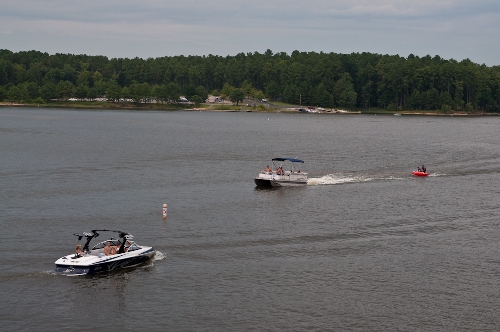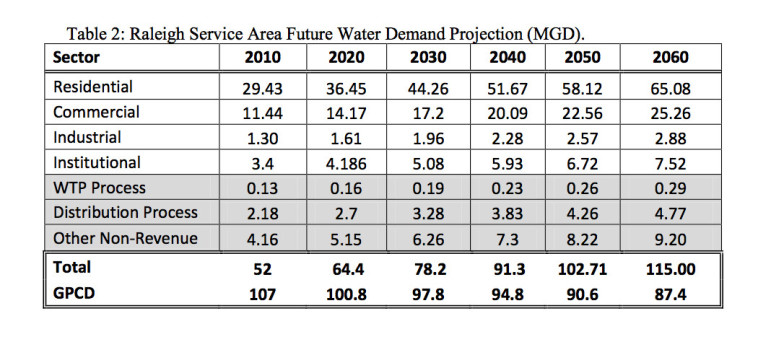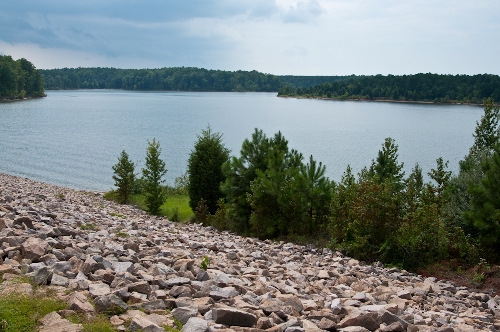In 50 years, Raleigh is going to need more drinking water, but no one is quite sure from where it’s going to come.
One of the options the city is exploring is to reallocate some water within Falls Lake, Raleigh’s primary water source.
“The city of Raleigh has been pursuing new water options for at least seven years,” said Assistant Director of Public Utilities Kenny Waldroup.
The water in Falls Lake isn’t solely dedicated to Raleigh’s water consumers. The water within the lake is also used for recreation, downstream water quality and flood and drought management.

Boaters enjoy Falls Lake.
City staff and the Army Corps of Engineers are researching the possibility of reallocating some of the water currently used for downstream water quality. This water is used to make sure the natural environment and ecosystem of the Neuse River and creeks continue to stay healthy.
Water sent downstream is also used as drinking water for Raleigh’s southern neighbors in Johnston County.
If found to be viable and approved, more water would be allocated for drinking and less for water quality. To make up for the decrease, Waldroup said more water would be released into the river from the city’s water treatment plants.
Some water from the treatment plants is already sent downstream.
Although Raleigh’s water supply consists of treated wastewater that has flowed downstream to Falls Lake, state laws say the city can’t pump its own wastewater back into the reservoir. Waldroup said staff are exploring the option of requesting a state law change for small amounts of water. Even if the city were to move in that direction, it would only supply a portion of the water that Raleigh will need to sustain a growing customer base.
Numbers by the Gallon
The city has about 500,000 water customers within Wake County, including those in municipalities such as Garner, Wendell and Zebulon.
Waldroup said those 500,000 customers use about 50 million gallons a day. That number of water users is expected to nearly double by 2040. By 2060, Raleigh needs to plan for 1.3 million water users.
Waldroup said for every 500,000 the city needs to expect to provide about 50 million gallons per day. However, with continued water conservation and efficiency, Waldroup said in 2060 the city could only need to account for an additional 38 million gallons per day.

Little River Reservoir isn’t Enough
The city is also exploring the potential of creating an additional reservoir out of the Little River, which is located just east of Rolesville.
Before that can happen, the city needs to explore all other alternatives that would have less of an environmental impact.
Waldroup said even the Little River Reservoir isn’t enough to meet Raleigh’s growing water needs. The reservoir would only provide 14 million gallons a day, leaving the city with a 24-million-gallon deficiency.
Along with the reservoir and the reallocation, the city is also looking at three other alternatives to pull water from the Neuse at other locations either above or below Falls Lake. But because all will draw from the same source, only one approach could be used.
“All [three] basically use the Neuse River,” Waldroup said.
Why So Dire?
Raleigh’s founders likely weren’t taking water access into consideration when they decided to build North Carolina’s capitol city.
Waldroup said Raleigh is in the unique situation of having the worst access to additional water sources of any other area in the state.
Even with the area’s recent drought history, rainfall isn’t really a problem. The problem lies with storage. Because of its location near the headwaters of Falls Lake and the lack of abundant watershed north of the lake, there really isn’t a good place to store all of that rainwater for city use.
Federal clean water and environmental laws make it nearly impossible to build more storage.
State laws also make it nearly impossible for Raleigh to take water from other reservoirs such as Jordan Lake or Kerr Lake. Waldroup said transferring water between basins is also very controversial.
The amount of water coming into Falls Lake has been decreasing during the past 83 years. The amount of water decreased at a rate of about 1 percent per year until about 30 years ago when it began to decrease at 2 percent per year. This decrease has an effect on Raleigh’s current and future water supply.
